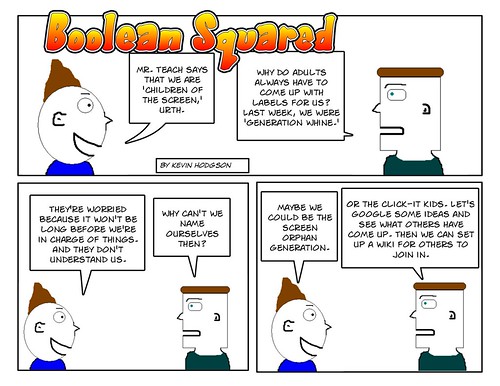(from my comic, Boolean Squared)
On our last day of school a few weeks ago, our district technology coordinator was in my room, marking down the specifications of the laptops in the cart that is housed in my classroom. I thought she might just be updating her files but she said the state is requiring all school districts to do a technology needs assessment connected to the roll-out of the PARCC assessment not far down the road. In other words, the state is trying to figure out what districts can handle the technology aspect of the test, which will include at least submission electronically and may include some media component (early iterations of PARCC materials suggested a podcast by students to demonstrate voice and stance.)
This week, I have been working with teachers and administrators in another school district, and this issue of technology capabilities came up once again. The school, in a struggling urban setting, does have a fair number of computers (three labs and two carts) but sister schools in the same district have almost nothing, and all of the schools are losing funding for other technology investments due to budget cuts.
Never mind the pedagogy of using technology as a means for writing and literacy (that thing that I find so important) — schools are struggling just to have enough working computers, access to Internet broadband connectivity, and more. And if PARCC assessments are going to suck up computer time for testing, that just leaves less time for students to be using that technology for meaningful writing and exploration.
It’s a tricky issue, and yet, it makes sense that an assessment would use and value technology as a means of writing and publishing, right?
This all came to mind this morning as I was reading through an interesting document from Louisiana, which has done its own technology capability inventory. It provides a great overview of what it has found in its school districts, and my guess is that most states will echo what Louisiana has found, including:
- The unknown elements of PARCC (window of testing, criteria of expectations) makes it difficult to know exactly what schools need to be ready;
- Internet connectivity is an obstacle to test implementation (and the state suggests an alternative test that does not require bandwidth or Internet and PARCC documents indicate they are developing a non-tech alternative);
- Logistical issues are vexing, as computers in classrooms and other public spaces would have to be used for testing, which is less than ideal for students working on a high-stakes test, and computer labs would have to be allocated for assessment for long stretches of time
- The lack of physical space for all of the required numbers of students testing in the same time window is a logistical nightmare (my term) for schools;
- And lack of professional development for teachers and technical support for these shifts.
These are issues that go beyond the Common Core standards, obviously, and given the tight budgets these days, I wonder how districts and states are going to meet these technical needs. PARCC itself has an “instructional technology purchasing guide” for districts that shares some minimum capabilities for any new computers. (note that tablets are included in allowable devices)

Kevin

Kevin,
Thanks for this thoughtful post and sharing what you have discovered so far. We are wrestling with what PARCC means in Ohio as well. It is further compounded with state funding cuts that many districts have dealt with in the last two years.
You are more optimistic than me though in saying that PARCC is valuing tech as a form of writing. Methinks this has more to do with making more $ than lifting up the use of tech to support writing.
Thanks again,
Tony